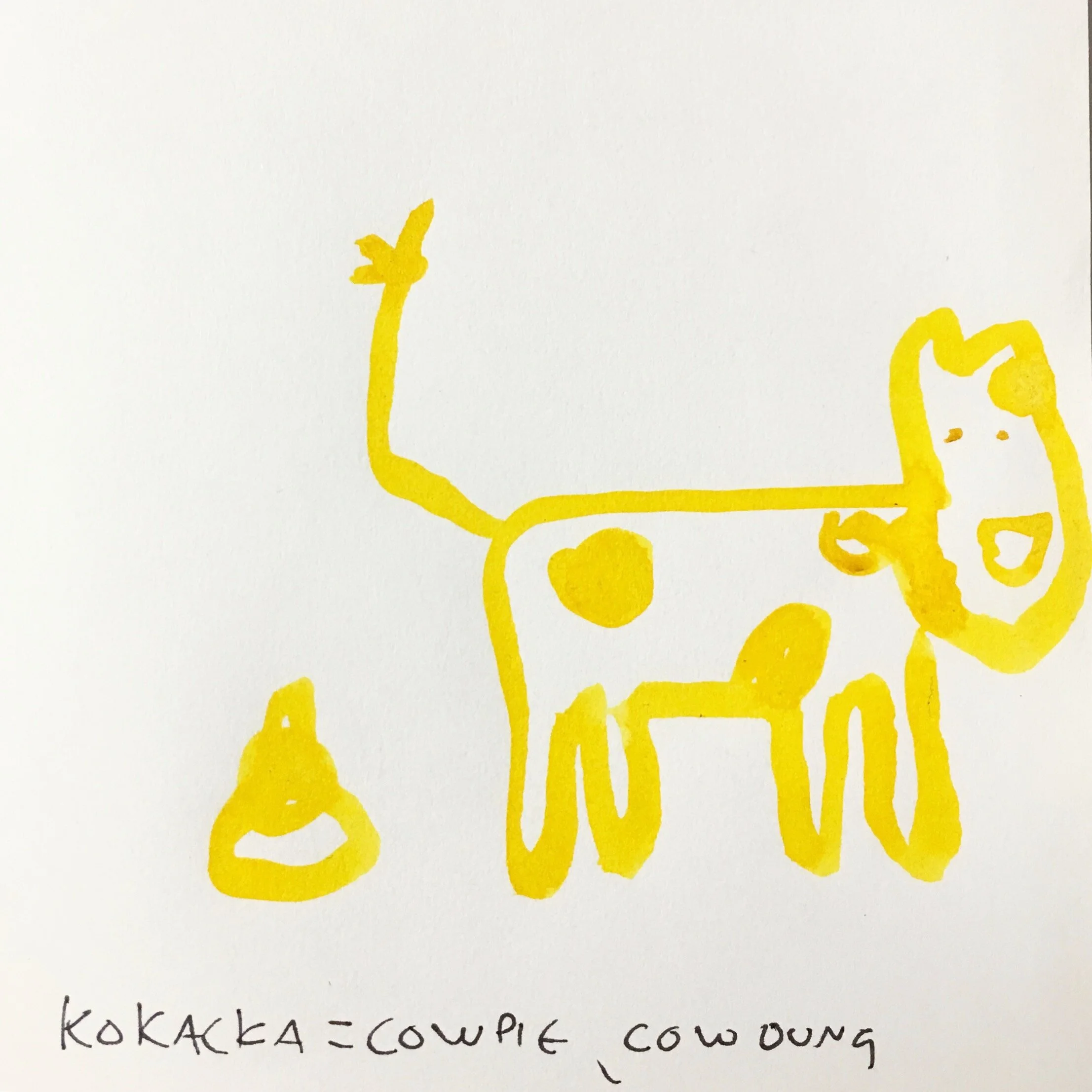AI, Cows and earthworms, with holiday book recommendations!
In a recent episode of Finnish podcast Herrasmieshakkerit (Gentleman hackers) , there was an interview with Arttu Lehmuskallio, the head of Finnish National Cyber Security Centre, who briefly discussed how cows have about five computers each. As I am sitting and writing this with my laptop and only have two other computing devices with me (my clock and my phone), I am feeling a bit jealous. Whether the cows surf the Intermoo or watch the Cowflix or not, this bit of information goes to show how digital processes envelop even the picturesque image of a pure countryside and the milking of the cow early in the morning; it is done by computers.
Hayles has argued that the relationship we have with the computational processes is symbiotic, that in a similar fashion as our life is dependent on being with symbiosis with other lifeforms, from gut-bacteria to bigger flora and fauna, we are dependent on the computational processes that entwine with our everyday experiences (Hayles, 2019; 2017). Furthermore, these processes do not always originate or focus on the user but happen in ways we are not at all times aware of. This means that digital processes have cognitive abilities; they create, react, respond, analyze, and alter information and experience. Hayles calls these digital processes nonconscious cognition, denoting the fact that even though these processes can be said to have cognition, i.e., they can react and respond, the talk of general artificial intelligence, the transhumanists wet dream of uploading brains into the cyberhive, are still long-off. However, Hayles continues remarking that as our lifeworld is full of these nonconscious cognitizers, for instance, it is estimated there are approximately 20 billion IoT-devices in 2020 (probably most of them used by cows) the effects these cognitizers have is noteworthy. Therefore these devices, networks, and processes play an active and reactive role in individuals' experienced world as in the world in general. For instance, stock markets are largely steered by algorithms, affecting the values of millions of companies and even national and global strategies (Washington, 2012). Hayles suggests that instead of thinking of these processes and devices in terms of networks, we should consider them as assemblages "because the configurations in which systems operate are always in transition, constantly adding and dropping components and rearranging connections. For example, when a person turns on her cell phone, she becomes part of a nonconscious cognitive assemblage that includes relay towers and network infrastructures, including switches, fiber optic cables, and/or wireless routers, as well as other components. With the cell phone off, the infrastructure is still in place, but the human subject is no longer a part of that particular cognitive assemblage." (p.11 (Hayles, 2017). The idea of assemblage brings forth the breadth of complicated situations and compositions these digital processes form in everyday life, enabling us to comprehend the significance and interconnectedness of these processes better.
Recently I was asked to hold a short presentation for cultural, administrative workers at the Finnish Ministry of Education and Culture on the subject of what should cultural workers know about AI in 2019? When thinking of the question, I thought of the current advances in AI and art, from GAN's (General Adversary Networks) to the text-based algorithms like GPT-2. Both of these display a sophisticated sorting of pixels or letters into convincing arrays of images and texts suitable for humans. However, the problem for me with these is the lack of rigour and vibrancy. Many, or even most of them feel uninspiring and dull. Much in a same way that we can generate effects on photos through filters, using AI in this way often lacks the intention or feels superimposed. GAN images are always just images generated through GAN: a set of algorithms that are able to sort and curate massive amounts of data. Artists have tried editing them with other digital tools, or painting them on canvas, but the distinct style of the algorithm is there. Poetically thinking the distinct mark of the algorithm is interesting: what does the algorithm portray, what is the meaning of it. Still, the bland truth is that the algorithm does not think (it's a nonconscious cognitizer), it maps an optimized function to pixels by going through datasets fed to it by humans. Often more interesting results come when the artists train the algorithms with their data; maybe even more exciting things could come if artists would create their algorithms? Similar blandness happens with the GPT-2, a text creating algorithm hyped as a tool too dangerous to share. Nowadays, one can try it on this website. Whereas it creates some compelling texts that could be used in the current consumer economy as filler texts for newssites (to escape from paying to real journalists and thus save money and therefore make more money for shareholders), it does not portray a higher intelligence trying to communicate with us mere mortals. Sure enough, we can use our imagination to find meaning or logic to the words. Still, again, in reality, there is no intention or higher machine consciousness discussing with us, just a logically arranged set of rules derived from vast sets of texts.
This is not to say that the use of such tools in artistic work would be in vain, on the contrary, experimentation is vital in artistic work, but what is often lost with hyping the use of AI in such works is the nature of the very tools; instead of intelligence (in way we understand it in general), the algorithms are only able to do some basic cognitive tasks. This, of course, is not a small feat, but almost an impossibly long jump from the human intelligence (whatever it is, or as one might wonder nowadays-if it even exists). As artist and researcher Janelle Shane puts it, AI has the capacity of an earthworm. And as it non-arguably is fascinating to do art with worms, we should recognize -and appreciate- it as it is, nothing more and nothing less. Putting it in such contexts might surface the challenges and issues better as well.
Another problem with Gans and other machine learning algorithms is that they are not neutral, not objective, but deeply political, deeply ideological, deeply involved with gender, race, and other issues. Fortunately, many artists do bring forth these problematics in their works and rightly so, as these problems are deep and hard to fix. Unfortunately, some artists are not aware of the problematics. For instance, the (too much) talked about AI artwork by artist group's Obvious, the portrait of Edmund de Bellamy is an example of generated imagery that continues the western canon of portraying important males. Said to be a portrait made by AI in the fashion of 1800th-century portrait sketches, the image depicts an oil color-like sketch of a man in a black coat. The image is printed on canvas and mounted on large golden frames. The work fuses neatly into the western canon of portraits of important males, almost without any blasphemy, anarchy or revolts. - So what if a white male did not paint the image, it is done with nearly the equivalent of it, the machine learning algorithm. (Sidenote: the work was not done by AI but through the process of selection by humans, and the creator of the algorithm was not even the artists group Obvious but Robbie Barrat who had shared the code in the Github.)
An example of an another way of working with the nonconscious cognitive assemblages, comes from two artists, Sougwen Cheng, a Lumen prize winner and from the musician Holly Herndon and her lates work. Cheng, whose work is primarily focused on collaborative drawing with robots, wrote after receiving the Lumen Prize this year:" In these deeply uncertain times, I find myself thinking of Donna Haraway's writing in Staying With The Trouble: "It matters what worlds world worlds. We become together or not at all." Collaboration, for me, is a way to steer away from "a technophobic spiral, by conceiving of humans & machines as interacting parts of complex adaptive systems." Similarly, Herndon, who trained an AI with samples of her voice, that she then used in collaboration with her singing and with other musicians, wrote, "There's a pervasive narrative of technology as dehumanizing, We stand in contrast to that. It's not like we want to run away; we're very much running towards it but on our terms. Choosing to work with an ensemble of humans is part of our protocol. I don't want to live in a world in which humans are automated off stage. I want an AI to be raised to appreciate and interact with that beauty." Both of these statements acknowledge the nonconscious cognitive assemblages and reflect on the future of such assemblages. They do not try to portray something as a continuation of a cultural canon or generate imagery through large datasets of already existing artworks. Instead, they try to work with and further with these nonconscious cognitizers. These kinds of profoundly critical and well-thought-out uses of AI are inspiring, they take a different position to these technologies, one that is not steered by hype, effortlessness, but by thinking the directions, challenges, and possibilities these technologies bring forth.
As I am writing this, I am still picturing cows watching the latest episode of Cowmaiden's tales or earthworms writing code. The end of the year is drawing in and I might need a vacation. I ended the presentation at the ministry with three book recommendations, that take the questions of AI into bit different territories and perspectives. I will do it here as well.
Ian McEwan: Machines Like Me
Jeanette Winterson: Frankissstein -a Love Story
N. Katherine Hayles: Unthought: The Power of the Cognitive Nonconscious
First is Ian McEwan's Machines like me, which does an admirable job portraying the possible challenges that arise with a more sophisticated AI.
Second is Jeanette Winterson's Frankissstein, a love story, which is a lovely retelling of Frankinstein with a twist of sex robots, neo-liberal hypercapitalism, and some transgender issues.
Last is N. Katherine Hayley's newest book, Unthought, The Power of the Cognitive Nonconscious, which conveys the world-renowned literature professors and posthuman thinkers, thoughts on artificial intelligence - highly recommended!
References
Hayles, N. K. (2017). Unthought. Chicago: University of Chicago Press. Retrieved from http://www.bibliovault.org/BV.landing.epl?ISBN=9780226447919
Hayles, N. K. (2019). Keynote. Proceedings from Moral Machines Ethics and Politics of the Digital World, University of Helsinki Helsinki.
Washington, G. (2012). 84% of All Stock Trades Are By High-Frequency Computers … Only 16% Are Done By Human Traders Zero Hedge. Retrieved from http://www.zerohedge.com/contributed/2012-17-26/84-all-stock-trades-are-high-frequency-computers-%E2%80%A6-only-16-are-done-human-tra




